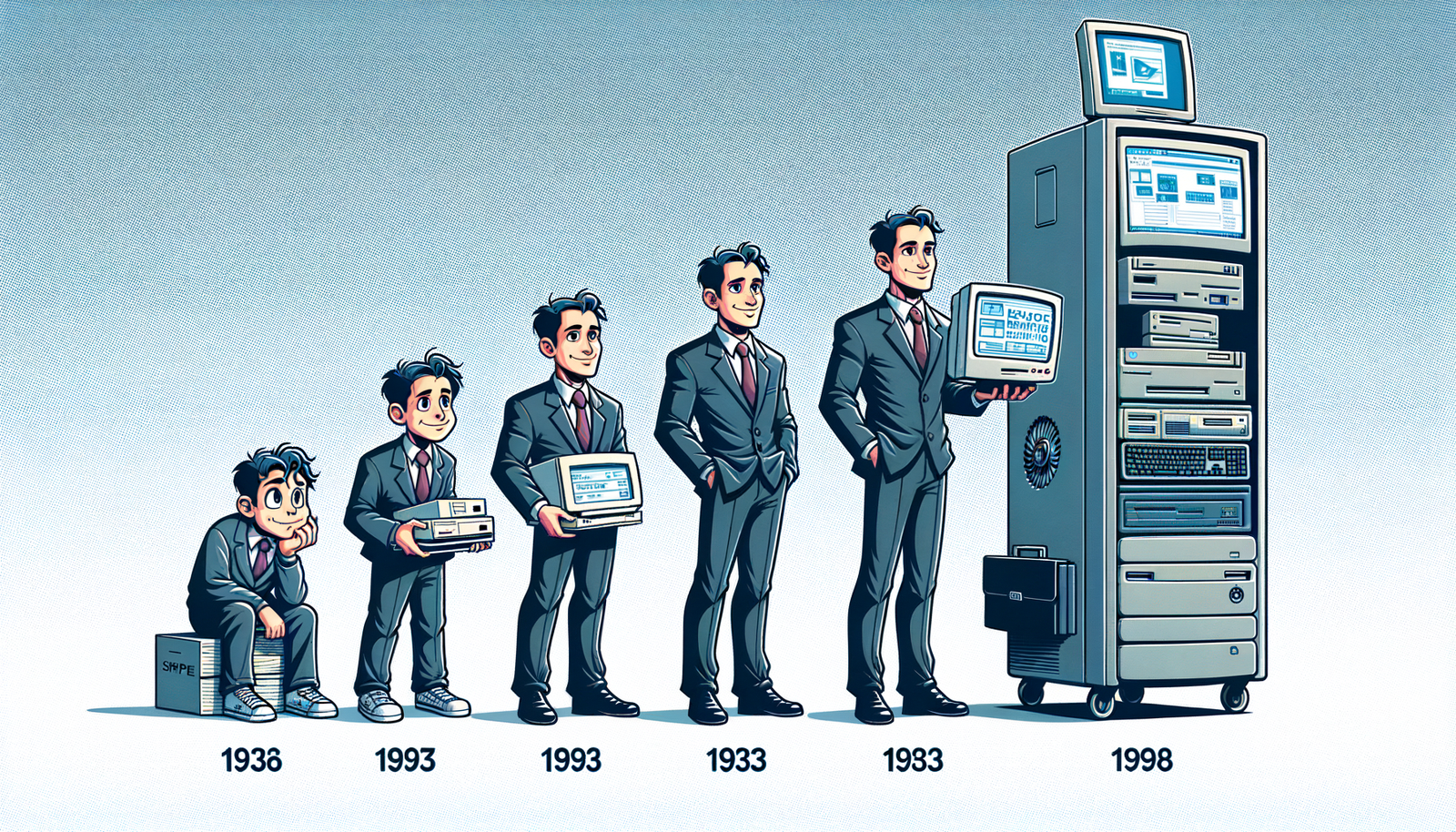Your Cart is Empty
Customer Testimonials
-
"Great customer service. The folks at Novedge were super helpful in navigating a somewhat complicated order including software upgrades and serial numbers in various stages of inactivity. They were friendly and helpful throughout the process.."
Ruben Ruckmark
"Quick & very helpful. We have been using Novedge for years and are very happy with their quick service when we need to make a purchase and excellent support resolving any issues."
Will Woodson
"Scott is the best. He reminds me about subscriptions dates, guides me in the correct direction for updates. He always responds promptly to me. He is literally the reason I continue to work with Novedge and will do so in the future."
Edward Mchugh
"Calvin Lok is “the man”. After my purchase of Sketchup 2021, he called me and provided step-by-step instructions to ease me through difficulties I was having with the setup of my new software."
Mike Borzage
Design Software History: The Evolution and Impact of Reverse Engineering Software in Modern Design
October 20, 2024 7 min read


Reverse engineering has emerged as a pivotal force in the realm of design, offering a bridge between existing physical products and innovative redesigns. By deconstructing products to understand their fundamental components and functionalities, designers and engineers can glean invaluable insights that drive the creation of superior and more efficient designs. The process entails dissecting an object to ascertain its design characteristics, often leading to enhancements that propel industries forward. In an era where technological advancement is rapid, reverse engineering serves as a vital tool for companies aiming to stay ahead of the curve, ensuring that they not only comprehend the intricacies of current technologies but also harness this knowledge to pioneer new frontiers in design. The significance of reverse engineering in design cannot be overstated; it enables the rejuvenation of legacy parts, facilitates compatibility in the integration of new systems, and fosters innovation by building upon existing frameworks.
The evolution of reverse engineering software tools has been a collaborative effort, with numerous key figures and companies contributing to its advancement. Notable among these are industry giants such as Parametric Technology Corporation (PTC), which introduced groundbreaking solutions like Creo, and Siemens, with its influential Solid Edge software. Visionaries like Dr. Samuel Geisberg, the founder of PTC, played instrumental roles in shaping the tools that have become staples in the industry. Companies like Autodesk have also been at the forefront, providing accessible design software that integrates reverse engineering capabilities. The collaborative efforts of software developers, engineers, and technologists across these organizations have continually pushed the boundaries, resulting in sophisticated tools that greatly enhance the efficiency and accuracy of reverse engineering processes. Their contributions have not only advanced the software but have also significantly impacted how industries approach design and manufacturing on a global scale.
Historical Development of Reverse Engineering Software
The concept of reverse engineering dates back to ancient times, where craftsmen would deconstruct artifacts to understand their construction and replicate or improve upon them. In the modern era, the early practices of reverse engineering were prominently seen in manufacturing and software development. Manufacturers would disassemble competitor products to study their components and functionalities, aiming to produce similar or improved versions. In the realm of software, reverse engineering was applied to understand proprietary code, enabling developers to create compatible software or identify vulnerabilities. These early methods were largely manual and time-consuming, relying heavily on the expertise and meticulous effort of engineers and technicians. The need for more efficient and precise tools led to the development of specialized software that could handle complex reverse engineering tasks with greater speed and accuracy.
The evolution of software tools in reverse engineering has been marked by significant advancements from basic drafting methods to sophisticated 3D modeling. Initially, engineers relied on simple Computer-Aided Design (CAD) programs that provided rudimentary drafting capabilities. As technology progressed, the introduction of Computer-Aided Manufacturing (CAM) and Computer-Aided Engineering (CAE) software enhanced the ability to not only design but also simulate and analyze products. The advent of 3D scanning technologies revolutionized the field, allowing for the capture of precise physical data to be used in digital models. Companies like Geomagic and Rapidform (now part of 3D Systems) developed software that could process scanned data into usable 3D models, significantly streamlining the reverse engineering process. This evolution has culminated in advanced solutions that integrate scanning, modeling, and analysis, providing a comprehensive toolkit for engineers and designers.
Key milestones in the development of reverse engineering software highlight the contributions of influential companies that have shaped the industry. PTC's Creo, formerly known as Pro/ENGINEER, was one of the first parametric, feature-based solid modeling software, introducing capabilities that greatly enhanced design flexibility and efficiency. Siemens' Solid Edge introduced synchronous technology, combining the speed of direct modeling with the control of parametric design, a significant advancement in handling complex models and facilitating reverse engineering tasks. Additionally, the integration of reverse engineering modules into mainstream CAD software, such as Autodesk Inventor and SOLIDWORKS, made these tools more accessible to a broader range of professionals. These milestones reflect the industry's commitment to advancing reverse engineering capabilities, ensuring designers have the tools necessary to meet the evolving demands of modern manufacturing and design challenges.
Technological Advances in Reverse Engineering Tools
The underlying technologies of reverse engineering tools have seen substantial advancements, particularly in the areas of 3D scanning and digital point cloud processing. 3D scanning technology has evolved from simple laser scanners to sophisticated devices capable of capturing high-resolution, accurate representations of complex geometries. Technologies such as structured light scanning and photogrammetry have expanded the possibilities, allowing for the detailed capture of intricate surfaces and textures. Digital point cloud processing has also advanced, enabling the efficient handling of vast amounts of data generated by 3D scans. Software algorithms for noise reduction, surface fitting, and feature recognition have become more sophisticated, facilitating the transition from raw scan data to usable 3D models. These technological strides have significantly reduced the time and effort required in the reverse engineering process, enhancing productivity and precision.
Modern reverse engineering software boasts a range of capabilities that have transformed how engineers and designers approach their work. Key among these are feature extraction, which allows the identification and isolation of specific geometric features within a scanned model, and mesh modeling, which involves creating a 3D mesh representation of a scanned object. The software can also convert these models into CAD formats, enabling further manipulation and integration into design workflows. Advanced tools incorporate functions for editing and optimizing meshes, ensuring that the models are of high quality and suitable for various applications. The ability to seamlessly integrate scanned data into CAD environments has bridged the gap between physical objects and digital design, facilitating more iterative and flexible design processes.
The capabilities of reverse engineering software have been significantly impacted by advancements in hardware, particularly 3D scanners. Manufacturers such as Faro Technologies and Hexagon AB have developed state-of-the-art scanning devices that offer exceptional accuracy and speed. Faro's laser scanners are renowned for their precision in capturing detailed measurements of complex objects and environments, while Hexagon's Leica scanners provide high-speed, high-definition 3D data acquisition. These hardware improvements have expanded the applications of reverse engineering, enabling the capture of large-scale objects like buildings and industrial installations, as well as microscopic components. The synergy between advanced scanning hardware and sophisticated software tools has empowered engineers to undertake reverse engineering tasks that were previously unattainable, pushing the boundaries of what can be achieved in design and manufacturing.
Applications and Future Trends in Reverse Engineering
Reverse engineering software is currently applied across various sectors, each leveraging the technology to meet specific needs and challenges. In the aerospace industry, reverse engineering is used to recreate obsolete parts, perform failure analysis, and improve the design of components for better performance and safety. The automotive sector utilizes these tools for rapid prototyping, customization, and the restoration of classic vehicles where original parts are no longer available. In the realm of consumer products, companies employ reverse engineering to innovate and enhance product designs, ensuring they meet evolving consumer preferences and technological standards. Additionally, industries such as medical device manufacturing and architecture have adopted reverse engineering for the development of custom implants and the restoration of historical buildings, respectively. The versatility of reverse engineering software has made it an indispensable asset across these diverse fields.
Looking to the future, several trends are poised to shape the evolution of reverse engineering software. The integration with Artificial Intelligence (AI) and Machine Learning is expected to automate and optimize many aspects of the reverse engineering process. AI algorithms can enhance feature recognition, automate mesh repair, and predict design intent, thereby reducing manual effort and increasing accuracy. The shift towards cloud-based solutions is another significant trend, facilitating collaborative design and enabling teams to work simultaneously on reverse engineering projects regardless of geographical barriers. This approach enhances efficiency and accelerates the development cycle. Moreover, the advancement of augmented reality (AR) and virtual reality (VR) technologies may soon enable immersive reverse engineering experiences, allowing engineers to interact with digital models in a three-dimensional space. These trends signify a transformative period ahead, with reverse engineering software becoming more intelligent, connected, and user-friendly.
Conclusion
The transformative impact of reverse engineering software tools on the design process is profound. By enabling the meticulous analysis and replication of existing products, these tools have revolutionized how industries approach innovation and development. They have streamlined workflows, reduced time-to-market, and opened up new possibilities for customization and improvement. The ability to dissect and understand complex designs has empowered engineers and designers to build upon existing knowledge, fostering a culture of continuous improvement and creativity. Reverse engineering software has not only enhanced efficiency but has also contributed to higher quality products and solutions across various industries.
As technology continues to evolve, so too will the tools and methodologies of reverse engineering. Advancements in AI, machine learning, and collaborative platforms are set to further enhance capabilities, making the process more intuitive and accessible. The future holds the promise of even more sophisticated tools that can handle increasingly complex tasks with greater ease and precision. It is imperative for professionals in the design and manufacturing industries to stay informed about these emerging technologies. By embracing and adapting to these innovations, they can maintain a competitive edge and continue to drive advancements in their respective fields. The ongoing evolution of reverse engineering tools signifies not just a technological progression but also an exciting journey toward new horizons in design and manufacturing.
Staying abreast of emerging tools and methodologies is crucial in the dynamic landscape of design software. Professionals are encouraged to engage with the latest developments, participate in continuous learning, and explore the potential of new technologies. By doing so, they not only enhance their skillsets but also contribute to the collective advancement of the industry. The integration of cutting-edge reverse engineering software into design processes is not merely an option but a necessity for those aiming to innovate and excel. As the boundaries of what is possible continue to expand, embracing these tools will be key to shaping the future of design and manufacturing.
Also in Design News
Subscribe
Sign up to get the latest on sales, new releases and more …





